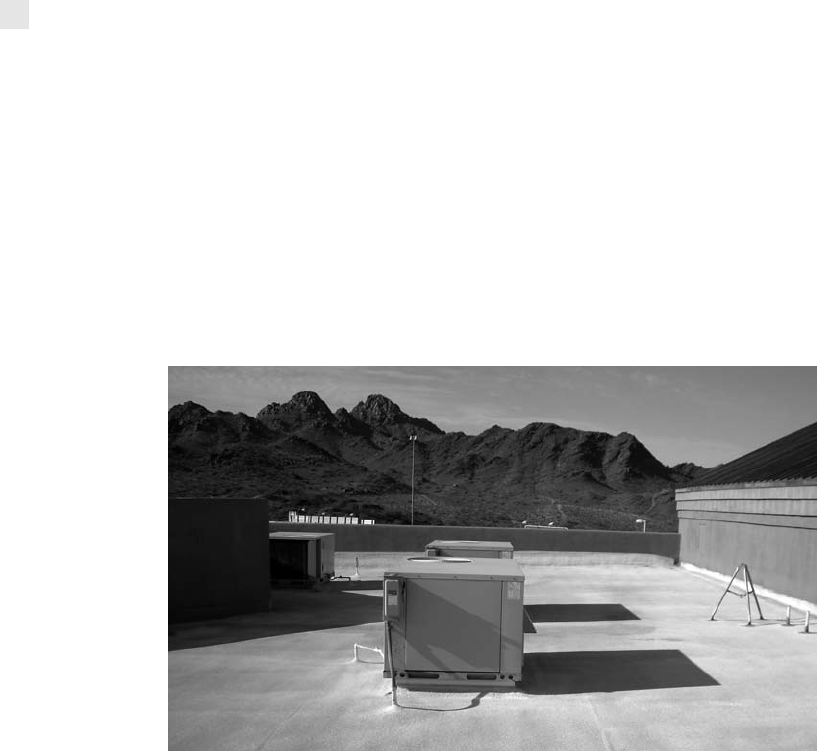
shading is the result of something blocking the sun that can be easily moved.
Examples include snow, bird droppings, dirt, and leaves. Temporary shading
factors are an important consideration when maintaining the modules or investi-
gating performance issues.
Building shading can be a serious concern. This type of shading is direct
shading and can result from chimneys, satellite dishes, and antennas. Designers
must consider both present and future structures when considering building
shading. Typically, the only way to fix this issue is by moving the modules.
Surrounding trees and buildings cause location shading. When designing a
system, consider the growth of surrounding trees during the next 20 years. Also,
consider the possibility of new taller buildings in the area.
When the PV components shade the modules, system shading results. Con-
sider wire and junction box placements and how they can result in shading issues.
Also consider the possibility of panels shading other panels. The issue may not be
obvious during the design or installation phase, but it can become an issue at a
different part of the year when the sun angle changes.
Direct shading can result in high energy loss. The closer the object is, the
darker the shadow. A dark shadow can result in 60 to 80 percent energy incidence
while partial shade may only reduce energy incidence by 30 to 50 percent.
We will discuss each shading type in more detail in the following section.
Solar Path
Understanding the motion of the sun is essential for proper PV system design. It is
also important when choosing a proper location for PV modules. The sun path dia-
gram illustrates the solar path. It is a very useful tool in determining shadows, which
greatly influence the PV
system design phase.
Shadow Types
A shadow cast on a PV
system has a great effect on
the solar yield. There are
several types of shading—
temporary shading, shading
resulting from the building,
shading resulting from the
location, system self-
shading, and direct shading.
The bottom line is that even
partial shading can be as
serious as total shading.
This roof overhang will produce shading that will move throughout the day.
Courtesy of PerfectPower, Inc.
CHAPTER 4 Site Review, Layout, Mounting Systems, and Building Integration 73

Temporary Shading
Temporary shading means that the shading on the PV modules does not last. It is
usually seasonal or cleanable. A good cleaning will remove most of the shading
listed below:
Snow
Leaves
Dust, soot, and soil
Bird droppings
Shading Resulting from the Building
The building’s shape and other structures mounted to the roof can all contribute to shading.
Shading in this photo is the result of AC units mounted to the roof.
Courtesy of PerfectPower, Inc.
Shading resulting from the building involves direct shadows. These shadows will
affect PV performance. Some shading can be avoided by moving or elevating the
PV modules or by removing the object causing the shading. Some examples of
building objects that cause shading include:
Chimneys
Antennas
Lightning conductors
Satellite dishes
Roof and façade overhangs
74 ADVANCED PHOTOVOLTAIC INSTALLATIONS

Shading Resulting from the Location
The shading in the right side of the photo is caused by tall palm trees.
Courtesy of PerfectPower, Inc.
Shading resulting from the location encompasses shading produced from a PV
site location, including neighboring buildings, overhead cables, or trees that can
shade the PV system.
Self-Shading
Although self-shading may not be an issue all year, during the winter when the sun moves
close to the horizon, any nearby component can contribute to self-shading.
Courtesy of PerfectPower, Inc.
CHAPTER 4 Site Review, Layout, Mounting Systems, and Building Integration 75
..................Content has been hidden....................
You can't read the all page of ebook, please click here login for view all page.
